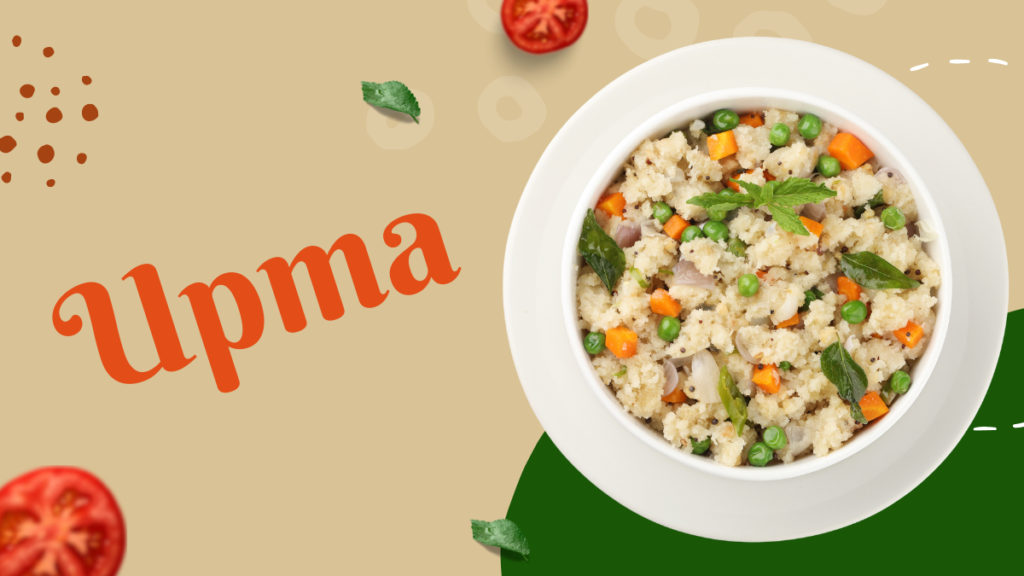A popular South Indian breakfast meal known for its rich, savory flavors and lovely texture, upma has won over lovers all over the world. Primarily composed of semolina (also known as rava or suji), this dish is not only filling but also adaptable, with multiple ways to customize it to suit various tastes. This post delves deeply into the technique of crafting the ideal upma, guaranteeing that each mouthful is a gourmet experience.
Ingredients for Upma Recipe
To make a delicious and authentic Upma Recipe, you will need the following ingredients:
- 1 cup semolina (rava/suji)
- 2 tablespoons ghee or oil
- 1 teaspoon mustard seeds
- 1 teaspoon cumin seeds
- 1-2 green chilies, chopped
- 1 teaspoon grated ginger
- 1 medium onion, finely chopped
- 1 small carrot, finely chopped (optional)
- 1/4 cup green peas (optional)
- 1/4 cup finely chopped bell peppers (optional)
- 8-10 curry leaves
- 2-3 tablespoons roasted cashews or peanuts (optional)
- Salt to taste
- 2.5 cups water
- 1 tablespoon chopped fresh coriander leaves
- 1 tablespoon lemon juice
Step-by-Step Guide to Making Upma

1. Roasting the Semolina
For your upma to have the perfect texture and flavor, roasting the semolina is an essential step.
Here’s how you do it:
- Heat a pan on medium flame.
- After adding one cup of semolina, dry roast it while stirring constantly until it takes on a light golden brown color. This should take between five and seven minutes. Stirring frequently will help you avoid scorching.
- When the semolina is roasted, move it to a platter and reserve.
2. Preparing the Seasoning
The flavor of Upma Recipe is derived from the spice.
Follow these steps to prepare it:
- Upma’s unique flavor comes from the seasoning.
- One teaspoon of mustard seeds should be added and allowed to sputter.
- One teaspoon of cumin seeds should be added and allowed to crackle.
- Grated ginger, curry leaves, and sliced chili peppers should be added. Sauté for a little period of time, or until the raw scent goes away.
- Add the onion, finely diced, and sauté it until it becomes transparent. Usually, this takes two to three minutes.
- Add the diced carrot, green peas, and bell peppers at this point if you’re using vegetables. Cook for 3–4 minutes, or until they are just beginning to soften.
- Add the roasted cashews or peanuts at this time for an added crunch.
3. Cooking the Semolina
Now comes the most important step: cooking the semolina:
- Once the pan is half full, add 2.5 cups of water and salt. Stir well.
- The water should be heated to a boil.
- Add the toasted semolina to the boiling water gradually, stirring frequently to avoid lumps. You must do this to get a really creamy and smooth upma.
- Lower the heat and continue cooking while stirring the mixture from time to time. thickened by the water absorbed by the semolina. It should take five or six minutes to complete.
4. Adding the Final Touches
To add more flavor and a spicy, new element to your upma, do the following:
- After turning off the heat, squeeze in one tablespoon of lemon juice. Toss to blend well.
- Add chopped fresh coriander leaves as a garnish.
5. Serving the Upma Recipe
You can now enjoy your delectable upma. Pickles, coconut chutney, or a dollop of yogurt can be served with upma for a hearty and filling lunch. Upma is best consumed hot.
Variations of Upma
Upma’s adaptability is one of its greatest features. Here are some alternatives that you could try:
Vegetable Upma
To make your upma more colorful and healthful, add several types of vegetables, such as peas, corn, tomatoes, and beans.
Tomato Upma
Add tomatoes to the seasoning mixture for a zesty variation. Particularly in Tamil Nadu, this variant is well-liked.
Bread Upma
Use stale bread cubes rather than semolina. This is a simple variant that takes minutes to prepare.
Poha Upma
For a lighter take on upma, try using poha, or flattened rice, in place of semolina. Prior to cooking, make sure the poha is drained and rinsed.
Vermicelli Upma
For a different texture, use seviyan (vermicelli) instead of semolina. Before using, dry roast the vermicelli.
Tips for Making the Perfect Upma
- Roasting the Semolina: If you want to avoid a sticky texture, always roast the semolina well.
- Proportions: Semolina to water ratio is important. You need about 2.5 glasses of water for every cup of semolina.
- Continuous Stirring: Lump-free addition of semolina to hot water requires constant stirring.
- Flavor Enhancers: You may boost the flavor and color of your upma with a pinch of turmeric powder.
- Nutty Flavor: Adding some roasted cashews or peanuts to the spice gives your upma a delicious crunch.
Health Benefits of Upma
In addition to being tasty, Upma Recipe has many health advantages.
- High in Fiber: Food fiber helps with digestion, and semolina has a lot of it.
- Low in Fat: Particularly when prepared with little to no ghee or oil, upma is a low-fat dish.
- Rich in Protein: Including nuts and veggies increases the dish’s protein level.
- Good for Diabetics: Semolina’s slow-releasing carbs contribute to steady blood sugar levels.
Conclusion
Upma is a delicious and adaptable dish that is simple to prepare and can be customized to fit a range of palates. Upma will delight your taste senses and keep you full for hours, whether you like it plain or loaded with nuts and vegetables. Make the ideal upma by following this detailed recipe guide, then savor a hearty and aromatic lunch.
Also Read:- The Ultimate Guide to Perfecting Your Homemade Pasta Recipe


